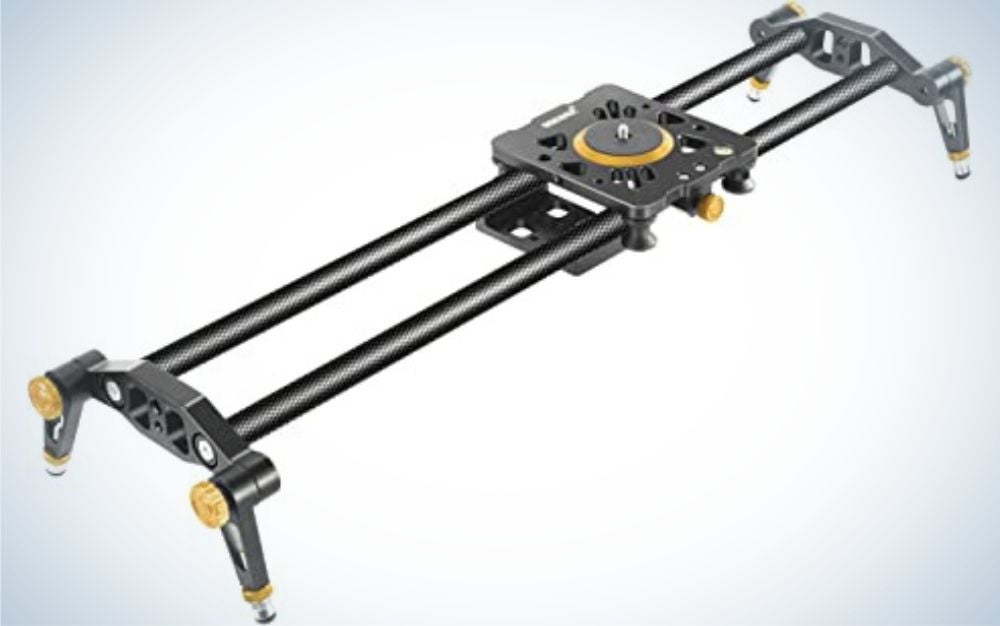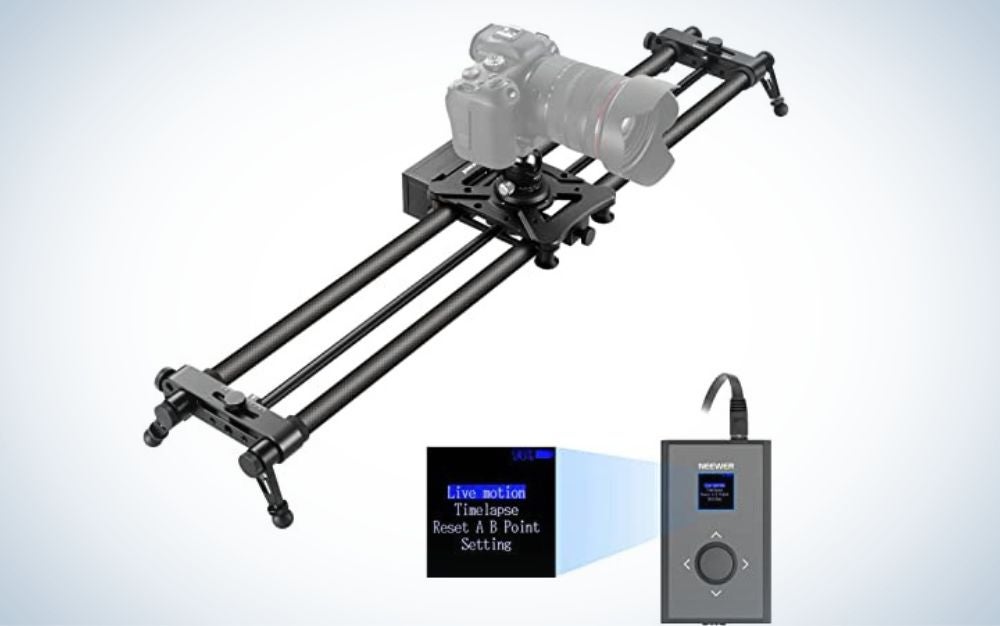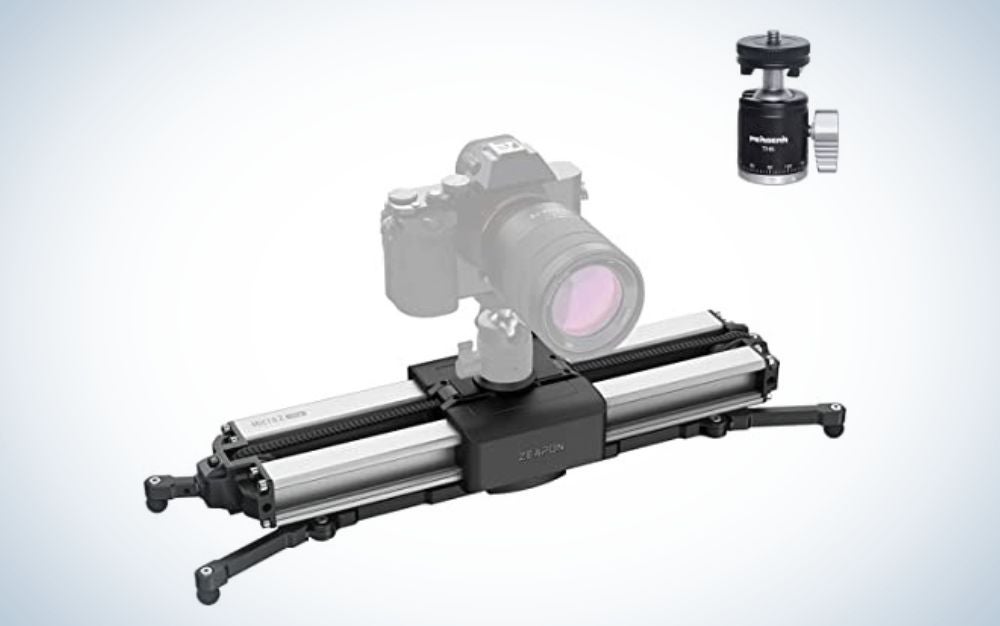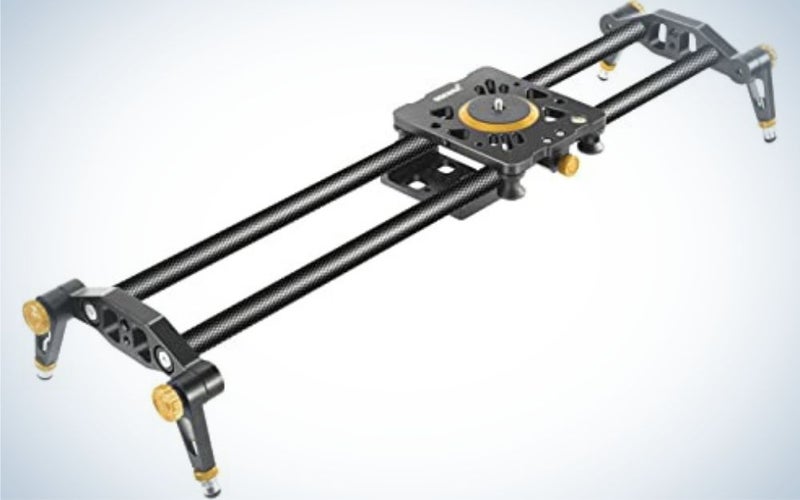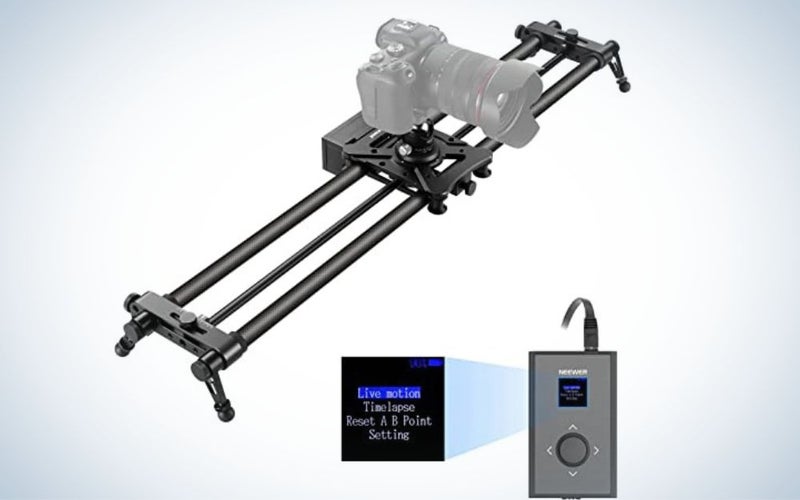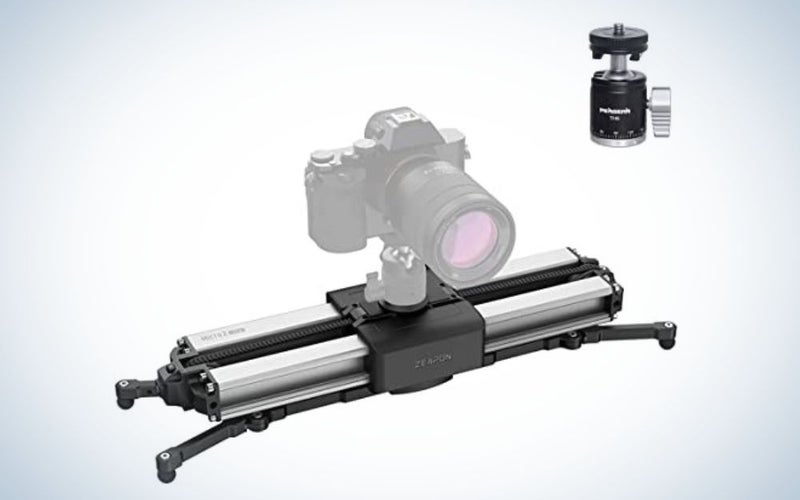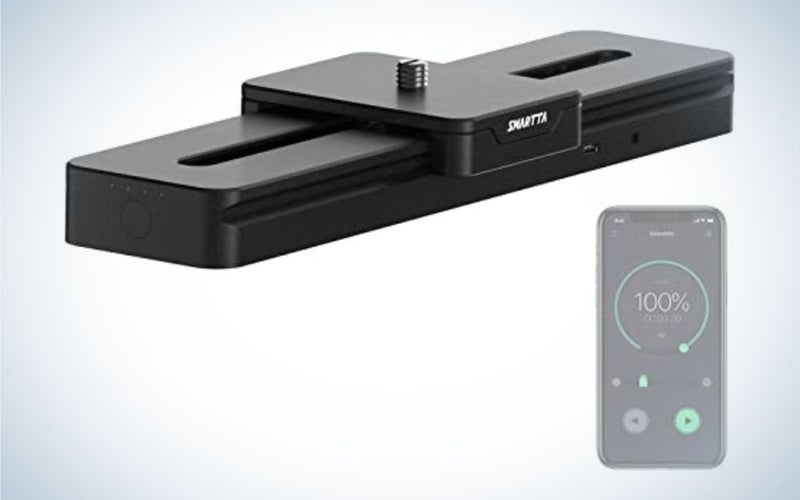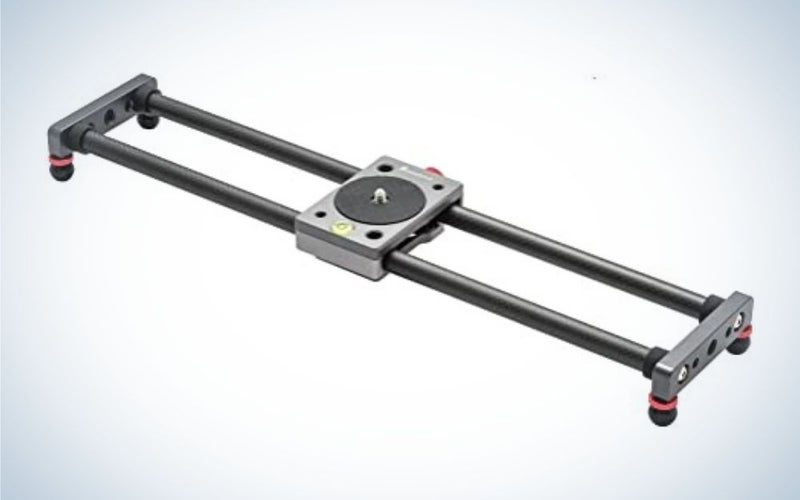
Camera sliders help you create smooth, dynamic shots that add interest and energy to your videos. They provide a stable base along which the camera can slide (hence the name) in a smooth, controlled way. They’re quick and easy to set up, fun to use, and the results make even small projects look like they have much bigger budgets.
A slider is a foundational filmmaking tool. With it, you can create smooth dolly shots that shift a viewer’s perspective, simulate jib movements for added impact, or create dramatic reveals. Sliders are also great for giving life to static shots, whether you’re filming interviews or highlighting products. They’re wonderful when shooting b-roll. The way you use a slider really is limited only by your imagination.
Sliders are small platforms for cameras that smoothly roll along a pair of rails or a central track. Travel distances can range from as long as a few feet, to a few inches. While cameras can mount directly to sliders, you can also use tripod or ball-heads for added positioning. Sliders are controlled either manually by an operator who literally pushes or pulls the camera as necessary, or by motors whose movements are easily programmed for automated use. Some also include motorized mounts for the cameras that turn as they slide, helping to keep the subject centered in the shot while shifting the viewer’s point of view. (This is ideal for interviews or vlogging.) The functionality is limited only by your budget and production needs.
There are a lot of companies making sliders at the moment, and finding the right one for your project can involve slogging through endless online listings. To help you find the best camera slider, we’ve compiled helpful tips and a list of the best camera sliders.
- Best manual: Neewer Carbon Fiber Camera Track Slider
- Best motorized: Neewer Motorized Camera Slider
- Best compact: Zeapon Micro 2 Plus Slider
- Best for travel: Smartta SliderMini 2
- Best cheap: ANNSM Mini Table Top Camera Slider
Things to Consider Before Buying the Best Camera Slider
Length and Travel Distance
Sliders typically range from about 9 inches to about 4 feet, and the right distance depends on how you plan to use it. You can create wonderful reveals and dolly moves with a long slider, or position it at an angle for dramatic, simulated jib shots. You can even track characters for short distances. But smaller sliders have their advantages, too—you’d be surprised how much energy moving the camera only a few inches can add to a shot. And smaller sliders fit into tighter spaces, they’re often faster to set up, and they’re much easier to take when traveling. Many content creators own more than one slider, but if that’s not within your budget, consider the types of projects you work on most when choosing a slider’s length.
Motors and Controllers
As mentioned previously, some sliders are controlled manually, some by a programmable motor. Manual controlled sliders are what you’re most likely to find on film and TV sets because they provide the most control and versatility. It’s easy to follow your creative muse when you don’t need to take time out to program in new movements. Manual sliders also generally cost less if budget’s a concern.
On the other hand, motorized sliders move the camera for you, freeing you up to run a second camera, work a remote-control focus unit, conduct interviews, deliver you commentary on-camera, or any of the other million things you could do on set. Because they’re programmable, motorized sliders can repeat their movements exactly, as many times as you need them to. They can also be set up to take time-lapse photos with precision positioning.
Materials
Most of the best sliders today use either aluminum or carbon fiber rails and or tracks. They balance strength, smoothness, and weight nicely. Carbon fiber is usually a little lighter, but aluminum often provides smoother rolling. Either will usually suit your needs.
Load Capacity
Not every slider is designed for use with every camera. Some smaller, light-weight sliders can’t support more than a DSLR; heavier, rigged out cinema cameras might slow up their motors or cause them to sag or bow. Load capacity is also much greater when the tripod is set up horizontally, especially on motorized units. If you’ve positioned the slider at an angle or even vertically, don’t expect it to lift as great a weight. Pay close attention to the manufacturer’s specs so you don’t risk causing damage to the slider or, even worse, your camera or lenses. That said, most sliders will accommodate DSLRs and smaller or stripped-down cinema cameras.
Feet and Mounting
Sliders can mount on tripods for creative positioning, or they can sit right on a flat surface. Mounting points usually include some at the center, as well as at both ends for added support (with the use of either two tripods or a pair of small light stands). Many sliders also have mounting points allowing them to be positioned vertically for especially dramatic movements.
Most of the better sliders also have adjustable feet that fold up with the unit’s not in use. These are only a couple inches tall, and they’re designed to keep the slider level and stable when not on a tripod—even on uneven ground. Some less expensive sliders’ feet can’t be adjusted though, and in those cases you’ll need to find a way to shim them or limit your use to flat tables or floors. And every once in a while you’ll encounter smaller, travel sliders with no feet at all. They work best when mounted, but again, with some creative shimming, you can use them on most surfaces.
When mounting longer sliders on tripods, its important to remember end supports. Otherwise, not only could the far sides of the slider bow down as the camera reaches them, but the whole set up could tip over! Be sure to factor in supports when pricing out your slider. Safety first!
Practice Makes Perfect
Sliders look easy to use, and to a certain extent, there’s not much to it. But when using it, you want your moves to be precise and smooth—especially in the beginning and end. Take the time to practice using your slider before you start shooting. Get a feel for how the camera moves when mounted to the carriage, develop muscle memory when choreographing complex moves. The end results will be worth the time you take to get them right, and you, your clients, and your fans will notice the difference!
Best manual: Neewer Carbon Fiber Camera Track Slider
Neewer
Why it made the cut: This versatile, lightweight, manually-driven slider is easily positioned to deliver dynamic movement whether you’re using a DSLR, cinema camera, or your phone.
Specs:
- Travel Length: 31 inches
- Load Capacity: 17.5 pounds
- Rail/Track Material: Carbon Fiber
Pros
- Lightweight carbon fiber
- Adjustable feet
- Can be mounted horizontally or vertically
Cons
- Extra support needed when mounted on a tripod
This motorless slider from Neewer has a travel distance long enough for many creative moves, but not so long that you’ll find it cumbersome to transport or set up. The carriage rolls smoothly along the carbon fiber rails, and attachment points at both ends and the center offer a wide range of creative positioning—you can even set it up vertically. The adjustable legs fold in and out, and extend an additional half-inch to handle placement on rough surfaces. However, if you’re mounting it on a tripod, you’ll need some sort of support system at either end to prevent bowing or tipping.
Cameras can mount directly to the carriage via a standard ¼-20 screw, and an included 3/8 adapter lets you also attach ball-heads or fluid heads of your choosing for even greater control. The high load capacity on this slider means you won’t have any trouble using even moderate size cinema cameras like a Sony FX9 or similar. That said, if you’re using the slider at an angle, prepare for a bit of a workout if your camera is on the heavier side—try to get the shot on the first take!
Best motorized: Neewer Motorized Camera Slider
Neewer
Why it made the cut: With multiple shooting modes and a strong, quiet motor, this slider is the next best thing to having an assistant.
Specs:
- Travel Length: 31.5 inches
- Load Capacity: 11 pounds horizontally, 5.5 pounds at a 45-degree angle
- Rail/Track Material: Carbon Fiber
Pros
- Three automated shooting modes
- Intuitive remote control
- Impressive load capacity
Cons
- No vertical positioning
- End supports required for elevated shooting
This motorized slider is designed for DSLRs and lighter cinema camera rigs. A 31.5-inch travel distance offers many creative opportunities, and you can mount it at a 45-degree angle for even more interesting shots. This slider can’t go full vertical, however; the motor and drive belt simply can’t accommodate it, and it lacks the mounting points. Besides delivering basic moves, two additional modes let you track stationary objects (when shooting interviews, recording a vlog, or creating product videos), or create 120-degree panoramas. You can also program the slider for time-lapse photography sessions.
Carbon fiber rails are lightweight and allow the carriage to roll smoothly, and the strong drive-belt prevents jitters. The legs are adjustable. The slider includes a ball-head, and it’s easy to replace with whatever type of head you prefer. Neewer’s slider mounts easily to tripods or stands, but like all longer sliders, you’ll need supports to keep the rig stable and safe.
Best compact: Zeapon Micro 2 Plus Slider
PERGEAR
Why it made the cut: Innovative mechanical design gives this manual slider a travel distance that’s longer than its actual size, making it an almost magically compact option.
Specs:
- Travel Length: 22 inches
- Load Capacity: 17 pounds horizontally, 9.9 pounds at other angles
- Rail/Track Material: Aluminum
Pros
- Expanding track
- Small and portable
- Excellent load capacity
Cons
- Can’t mount vertically
- Travel distance still a bit short
Zeapon’s cleverly designed slider actually expands as you move the camera, nearly doubling its length from 34.7cm to 56cm. When closed, the slider easily fits into a backpack or kit bag for traveling, while still providing creative opportunities when in use. Gear gets heavy, but at less than three pounds, the Micro 2 Plus won’t tire you out, and the slider sets up quickly. Four adjustable legs keep the unit level, and you can attach it to a tripod for positioning at different heights or angles. However, it can’t mount vertically using end attachments. The slider features fluid-damping technology for smoother motion, and a magnetic locking mechanism holds the rail system closed when not in use.
Best for travel: Smartta SliderMini 2
aircover
Why it made the cut: A tiny, battery-powered, motorized slider that fits in a fanny-pack is perfect for adding movement to videos when traveling.
Specs:
- Travel Length: 8 inches
- Load Capacity: 33 pounds horizontally, 2.76 pounds vertically
- Rail/Track Material: Aluminum
Pros
- Less than 11 inches long
- App-based control
- Battery-powered
Cons
- Very short travel distance
- No adjustable feet
Smartta’s tiny slider won’t out-perform larger units, with their higher weight capacities and longer travel distances. But try throwing one of those sliders in a backpack when you go for a hike! You can set up this motorized slider on the top of a peak, in front of a historic building, at a picturesque tourist location, on the table at a family reunion, or anywhere else inspiration strikes.
It holds and moves a whopping 33 pounds when horizontal, so sticking most cameras on it won’t be any trouble. However, when using the slider at an angle, weight is limited to 2.76 pounds before the motor gives out, so it’s really best for use with DSLRs or mirrorless cameras, camcorders, smaller cinema cameras like the Canon EOS C70 or Blackmagic Pocket 6K, or smart phones.The app-based control, which is available for both iOS and Android, supports time-lapse, stop-motion, loop, and curve modes, and features a library of presets (that can also be customized). The slider includes shutter-release cables compatible with a wider variety of cameras for time-lapse photography (check to make sure your camera’s covered). The rig is powered by a USB-rechargeable 1500mAh internal battery. This little wonder’s biggest downside is the lack of feet, adjustable or otherwise. This means that unless you’ve got it on a tripod, you’ll need to get creative with shimming to keep it stable on uneven ground as the camera moves. Maybe consider including a few popsicle sticks or pieces of cardboard in the bag with it.
Best cheap: ANNSM Mini Table Top Camera Slider
ANNSM
Why it made the cut: This no-frills slider provides smooth camera movements for beginners or people who want to keep their budgets tight.
Specs:
- Travel Length: 16 inches
- Load Capacity: 11 pounds
- Rail/Track Material: Carbon Fiber
Pros
- Inexpensive
- Solidly built
- Portable
Cons
- Short travel distance
- Feet aren’t adjustable
- Can’t handle heavier cameras
You get what you pay for with film equipment, and this inexpensive slider doesn’t do much more than move your camera from one side to another. However, if that’s all you want, you can’t go wrong with this solidly-constructed, light-weight unit. The carbon fiber rails provide a smooth rolling surface for the carriage, and have soft rubber bumpers at each end for gentler stops. Mounting points at the center and both end-caps allow the slider to be positioned at a variety of angles (including vertically) using a tripod. It’d be nice if the feet were adjustable, but at this price, you can afford to pick up some small shims to help level things out.
FAQs
Q: Wow do I choose a slider for my camera?
The best way to choose a slider for your camera is to start by thinking about the physical requirements of your camera—weight, in particular—and then eliminating sliders that can’t accommodate the load. From the remaining options, consider the types of projects you’ll be doing. Do you need something large for lots of movement? Small for portability? Does your slider require a motor? By letting your projects guide your purchase, you’ll always end up with the gear that’s right for you.
Q: What is a good length for a camera slider?
A good length for a camera slider is based on the shots you’re trying to get. Do you require a lot of movement? Will the slider need to fit into smaller spaces? And don’t forget portability—if you have access to a vehicle, longer sliders won’t be as much of an issue than if you plan on carrying it to a location. All these factors help determine whether a longer or shorter slider is right for you. That said, a two- to three-foot long slider often provides enough movement to add drama and energy to a scene. Smaller sliders might be too limiting, and longer ones can become cumbersome (and more expensive) with all the necessary supports.
Q: How do you use a motorized slider?
Motorized sliders are often used when you want repeatable camera moves. They’re also handy when you don’t have someone to operate the slider manually—for instance, when you’re a solo operator on a two-camera shoot. Vloggers might also find them helpful when filming themselves. Setting up a motorized slider is usually simple and straight-forward, often involving programming the carriage’s beginning and end points, and activating a particular shooting mode (like object tracking). The slider’s instruction manual will provide any specific information for setting up the unit. As always, when using a longer slider—whether motorized or not—don’t forget to provide adequate supports to prevent it from tipping over.
Final Thoughts
It’s a common assumption that longer sliders are better—after all, you can’t go wrong with more movement. But after exploring these basic filmmaking tools, it’s pretty clear that sometimes all you need to create drama and energy is a small amount of movement. Factors like portability, price, and overall functionality play an important role in establishing the top-contenders. Length plays a practical role, but it’s not the only consideration.
Our favorite slider was the manually-controlled Neewer Carbon Fiber Camera Track Slider because, in the end, it’s about the creative opportunities a slider provides a creator. Motorized sliders are powerful tools in certain situations, but there’s no beating the spontaneity and control provided by a manual unit. We were also impressed by the little Zeapon Micro 2 Plus slider—also a manual unit. The clever design provided a nice travel distance while maintain a compact and portable size. If you don’t need the length of our favorite motorized slider, also by Neewer, the Zeapon is an excellent choice.
Methodology
To compile our list of five of the best camera sliders, we first narrowed the field down to 10 units. To cut the selections further, we relied on our own experience as filmmakers and content creators who’ve used these and other sliders on innumerable top-tier shoots. We also consulted other professionals in the field, and read through industry web sites and review pages. We read the manufacturer’s spec sheets, and examined reviews left by buyers to get a variety of perspectives on what people liked and didn’t like about these sliders. There was no one key criteria in determining our favorite sliders, and we took into account travel distance, construction, load-bearing capabilities, mounting options, weight, overall versatility, and price. If a slider was motorized, we also looked at the different modes and functions provided by that motor and any control mechanisms.
The post Best camera sliders for 2022 appeared first on Popular Photography.
